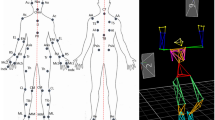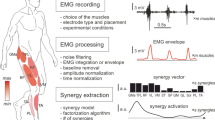Abstract
Movements by a standing person are commonly associated with adjustments in the activity of postural muscles to cause a desired shift of the center of pressure (COP) and keep balance. We hypothesize that such COP shifts are controlled (stabilized) using a small set of central variables (muscle modes, M-modes), while each M-mode induces changes in the activity of a subgroup of postural muscles. The main purpose of this study has been to explore the possibility of identification of muscle synergies in a postural task using the framework of the uncontrolled manifold (UCM) hypothesis employing the following three steps in data analysis: (i) Identification of M-modes: Subjects were asked to release a load from extended arms through a pulley system, resulting in a COP shift forward prior to load release. Electromyographic (EMG) activity of eleven postural muscles on one side of the body was integrated over a 100 ms interval corresponding to the early stage of the COP shift, and subjected to a principal component (PC) analysis across multiple repetitions of each task. Three PCs were identified and associated with a ‘push-back M-mode’, a ‘push-forward M-mode’ and a ‘mixed M-mode’. (ii) Calculation of the Jacobian of the system, which relates changes in the magnitude of M-modes to COP shifts using regression techniques: Subjects performed three different tasks (releasing different loads at the back, voluntarily shifting body weight forward and backward, at different speeds) to verify if the relationship between magnitudes of M-modes and COP shifts is task or direction specific. (iii) UCM analysis: Three tasks were chosen (load release in the front, arm movement forward and backward) which were associated with an early shift in COP. A manifold was identified in the M-mode space corresponding to a certain average (across trials) shift of the COP and variance per degree of freedom within the UCM (VUCM) and orthogonal (VORT) to the UCM was computed. Across subjects, VUCM was significantly higher than VORT when analysis at the third step was performed using a Jacobian computed based on a set of tasks associated with a COP shift in the same direction but not in the opposite direction. This result confirms our hypothesis that the M-modes work together as a synergy to stabilize a desired shift of the COP. Forward and backward COP shifts are associated with different synergies based on the same three M-modes.




Similar content being viewed by others
References
Alexandrov A, Aurenty R, Massion J, Mesure S, Viallet F (1998a) Axial synergies in parkinsonian patients during voluntary trunk bending. Gait Posture 8:124–135
Alexandrov A, Frolov A, Massion J (1998b) Axial synergies during human upper trunk bending. Exp Brain Res 118:210–220
Allum JH, Honegger F (1993) Synergies and strategies underlying normal and vestibulary deficient control of balance: implication for neuroprosthetic control. Prog Brain Res 97:331–348
Allum JH, Honegger F, Pfaltz CR (1989) The role of stretch and vestibulo-spinal reflexes in the generation of human equilibrating reactions. Prog Brain Res 80:399–409
Aruin AS, Latash ML (1995) Directional specificity of postural muscles in feed-forward postural reactions during fast voluntary arm movements. Exp Brain Res 103:323–332
Aruin AS, Latash ML (1996) Anticipatory postural adjustments during self-initiated perturbations of different magnitude triggered by a standard motor action. Electroencephalogr Clin Neurophysiol 101:497–503
Baratto L, Morasso PG, Re C, Spada G (2002) A new look at posturographic analysis in the clinical context: sway-density versus other parameterization techniques. Motor Control 6:246–270
Belen’kii V, Gurfinkel VS, Pal’tsev YI (1967) Elements of control of voluntary movements. Biofizika 10:135–141
Bernstein N (1967) The coordination and regulation of movements. Pergamon, London
Bizzi E, D’Vella A, Saltiel P, Tresch M (2002) Modular organization of spinal motor systems. Neuroscientist 8:437–442
Bouisset S, Lestienne F, Maton B (1977) The stability of synergy in agonists during the execution of a simple voluntary movement. Electroencephalogr Clin Neurophysiol 42:543–551
Collins JJ, De Luca CJ (1993) Open-loop and closed-loop control of posture: a random-walk analysis of center-of-pressure trajectories. Exp Brain Res. 95:308–318
Crenna P, Frigo C, Massion J, Pedotti A (1987) Forward and backward axial synergies in man. Exp Brain Res 65:538–548
Danion F, Duarte M, Grosjean M (1999) Fitts’ law in human standing: the effect of scaling. Neurosci Lett 277:131–133
Gelfand IM, Tsetlin ML (1966) On mathematical modeling of the mechanisms of the central nervous system. In: Gelfand IM, Gurfinkel VS, Fomin SV, Tsetlin ML (eds) Models of the structural-functional organization of certain biological systems. Nauka, Moscow, pp 9–26
Gollhofer A, Horstmann GA, Berger W, Dietz V (1989) Compensation of translational and rotational perturbations in human posture: stabilization of the centre of gravity. Neurosci Lett 105:73–78
Hair JF, Anderson RE, Tatham RL, Black WC (1995) Factor analysis. In: Borkowsky D (ed) Multivariate data analysis. Prentice Hall, Englewood Cliffs, NJ, pp 364–404
Holdefer RN, Miller LE (2002) Primary motor cortical neurons encode functional muscle synergies. Exp Brain Res 146:233–243
Horak FB, Nashner LM (1986) Central programming of postural movements: adaptation to altered support-surface configurations. J Neurophysiol 55:1369–1381
Horak FB, Nashner LM, Diener HC (1990) Postural strategies associated with somatosensory and vestibular loss. Exp Brain Res 82:167–177
Hughlings Jackson J (1889) On the comparative study of disease of the nervous system. Br Med J 17:355–362
Kilbreath SL, Gandevia SC (1994) Limited independent flexion of the thumb and fingers in human subjects. J Physiol 479:487–497
Krishnamoorthy V, Goodman S, Zatsiorsky VM, Latash ML (in press) Muscle synergies during shifts of the center of pressure by standing persons: identification of steadfast muscle groups. Biol Cybern
Latash ML, Scholz JF, Danion F, Schöner G (2001) Structure of motor variability in marginally redundant multifinger force production tasks. Exp Brain Res 141:153–165
Latash ML, Scholz JF, Danion F, Schöner G (2002a) Finger coordination during discrete and oscillatory force production tasks. Exp Brain Res 146:419–432
Latash ML, Scholz JP, Schöner G (2002b) Motor control strategies revealed in the structure of motor variability. Exerc Sport Sci Rev 30:26–31
Ledebt A, Bril B, Wiener-Vacher S (1995) Trunk and head stabilization during the first months of independent walking. Neuroreport 6:1737–1740
Massion J (1992) Movement, posture and equilibrium: interaction and coordination. Prog Neurobiol 38:35–56
Massion J, Gurfinkel V, Lipshits M, Obadia A, Popov K (1992) [Strategy and synergy: two levels of equilibrium control during movement. Effects of the microgravity]. C R Acad Sci III 314:87–92
Pozzo T, Berthoz A, Lefort L (1990) Head stabilization during various locomotor tasks in humans. I. Normal subjects. Exp Brain Res 82:97–106
Sabatini AM (2002) Identification of neuromuscular synergies in natural upper-arm movements. Biol Cybern 86:253–262
Scholz JP, Schöner G (1999) The uncontrolled manifold concept: identifying control variables for a functional task. Exp Brain Res 126:289–306
Scholz JP, Schöner G, Latash ML (2000) Identifying the control structure of multijoint coordination during pistol shooting. Exp Brain Res 135:382–404
Scholz JP, Danion F, Latash ML, Schöner G (2002) Understanding finger coordination through analysis of the structure of force variability. Biol Cybern 86:29–39
Schöner G (1995) Recent developments and problems in human movement science and their conceptual implications. Ecol Psychol 8:291–314
Shiratori T, Latash ML (2000) The roles of proximal and distal muscles in anticipatory postural adjustments under asymmetrical perturbations and during standing on rollerskates. Clin Neurophysiol 111:613–623
Simoneau GG, Leibowitz HW, Ulbrecht JS, Tyrrell RA, Cavanagh PR (1992) The effects of visual factors and head orientation on postural steadiness in women 55 to 70 years of age. J Gerontol 47:M151–158
Szturm T, Fallang B (1998) Effects of varying acceleration of platform translation and toes-up rotations on the pattern and magnitude of balance reactions in humans. J Vestib Res 8:381–397
Tresch MC, Saltiel P, Bizzi E (1999) The construction of movement by the spinal cord. Nat Neurosci 2:162–167
Vernazza S, Alexandrov A, Massion J (1996) Is the center of gravity controlled during upper trunk movements? Neurosci Lett 206:77–80
Vernazza-Martin S, Martin N, Massion J (1999) Kinematic synergies and equilibrium control during trunk movement under loaded and unloaded conditions. Exp Brain Res 128:517–526
Winter DA, Patla AE, Prince F, Ishac M, Gielo-Perczak K (1998) Stiffness control of balance in quiet standing. J Neurophysiol 80:1211–1221
Zatsiorsky VM, Duarte M (2000) Rambling and trembling in Quiet standing. Motor Control 4:185–200
Zatsiorsky VM, Li ZM, Latash ML (1998) Coordinated force production in multi-finger tasks: finger interaction and neural network modeling. Biol Cybern 79:139–150
Zatsiorsky VM, Li ZM, Latash ML (2000) Enslaving effects in multi-finger force production. Exp Brain Res 131:187–195
Acknowledgements
Supported in part by grants AG-018751 and NS-35032 from the National Institutes of Health, USA.
Author information
Authors and Affiliations
Corresponding author
Additional information
An erratum to this article can be found at http://dx.doi.org/10.1007/s00221-003-1779-8
Rights and permissions
About this article
Cite this article
Krishnamoorthy, V., Latash, M.L., Scholz, J.P. et al. Muscle synergies during shifts of the center of pressure by standing persons. Exp Brain Res 152, 281–292 (2003). https://doi.org/10.1007/s00221-003-1574-6
Received:
Accepted:
Published:
Issue Date:
DOI: https://doi.org/10.1007/s00221-003-1574-6




